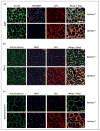New wrinkles in lipoprotein lipase biology
- PMID: 22123668
- PMCID: PMC3383841
- DOI: 10.1097/MOL.0b013e32834d0b33
New wrinkles in lipoprotein lipase biology
Abstract
Purpose of review: We summarize recent progress on GPIHBP1, a molecule that transports lipoprotein lipase (LPL) to the capillary lumen, and discuss several newly studied molecules that appear important for the regulation of LPL activity.
Recent findings: LPL, the enzyme responsible for the lipolytic processing of triglyceride-rich lipoproteins, interacts with multiple proteins and is regulated at multiple levels. Several regulators of LPL activity have been known for years and have been investigated thoroughly, but several have been identified only recently, including an endothelial cell protein that transports LPL to the capillary lumen, a microRNA that reduces LPL transcript levels, a sorting protein that targets LPL for uptake and degradation, and a transcription factor that increases the expression of apolipoproteins that regulate LPL activity.
Summary: Proper regulation of LPL is important for controlling the delivery of lipid nutrients to tissues. Recent studies have identified GPIHBP1 as the molecule that transports LPL to the capillary lumen, and have also identified other molecules that are potentially important for regulating LPL activity. These new discoveries open new doors for understanding basic mechanisms of lipolysis and hyperlipidemia.
Conflict of interest statement
There are no conflicts of interest.
Figures


Similar articles
-
[New insights in regulation factors of lipoprotein lipase].Yi Chuan. 2013 Jul;35(7):830-8. doi: 10.3724/sp.j.1005.2013.00830. Yi Chuan. 2013. PMID: 23853353 Review. Chinese.
-
GPIHBP1, an endothelial cell transporter for lipoprotein lipase.J Lipid Res. 2011 Nov;52(11):1869-84. doi: 10.1194/jlr.R018689. Epub 2011 Aug 15. J Lipid Res. 2011. PMID: 21844202 Free PMC article. Review.
-
Glycosylphosphatidylinositol-anchored high-density lipoprotein-binding protein 1 and the intravascular processing of triglyceride-rich lipoproteins.J Intern Med. 2012 Dec;272(6):528-40. doi: 10.1111/joim.12003. Epub 2012 Nov 1. J Intern Med. 2012. PMID: 23020258 Free PMC article. Review.
-
GPIHBP1 and Lipoprotein Lipase, Partners in Plasma Triglyceride Metabolism.Cell Metab. 2019 Jul 2;30(1):51-65. doi: 10.1016/j.cmet.2019.05.023. Cell Metab. 2019. PMID: 31269429 Free PMC article. Review.
-
GPIHBP1 is responsible for the entry of lipoprotein lipase into capillaries.Cell Metab. 2010 Jul 7;12(1):42-52. doi: 10.1016/j.cmet.2010.04.016. Cell Metab. 2010. PMID: 20620994 Free PMC article.
Cited by
-
The ANGPTL3-4-8 model, a molecular mechanism for triglyceride trafficking.Open Biol. 2016 Apr;6(4):150272. doi: 10.1098/rsob.150272. Open Biol. 2016. PMID: 27053679 Free PMC article. Review.
-
Mechanism of hypertriglyceridemia in CTP:phosphoethanolamine cytidylyltransferase-deficient mice.J Lipid Res. 2012 Sep;53(9):1811-22. doi: 10.1194/jlr.M021881. Epub 2012 Jul 4. J Lipid Res. 2012. PMID: 22764088 Free PMC article.
-
Offspring subcutaneous adipose markers are sensitive to the timing of maternal gestational weight gain.Reprod Biol Endocrinol. 2015 Mar 8;13:16. doi: 10.1186/s12958-015-0009-0. Reprod Biol Endocrinol. 2015. PMID: 25879645 Free PMC article.
-
Syndecan-1 Mediates Sorting of Soluble Lipoprotein Lipase with Sphingomyelin-Rich Membrane in the Golgi Apparatus.Dev Cell. 2019 Nov 4;51(3):387-398.e4. doi: 10.1016/j.devcel.2019.08.014. Epub 2019 Sep 19. Dev Cell. 2019. PMID: 31543446 Free PMC article.
-
Lipoprotein Lipase Deficiency in an Infant With Chylomicronemia, Hepatomegaly, and Lipemia Retinalis.Glob Pediatr Health. 2017 Jun 28;4:2333794X17715839. doi: 10.1177/2333794X17715839. eCollection 2017. Glob Pediatr Health. 2017. PMID: 28695157 Free PMC article. No abstract available.
References
-
- Brunzell JD, Deeb SS. Familial lipoprotein lipase deficiency, apo C-II deficiency, and hepatic lipase deficiency. In: Scriver CR, Beaudet AL, Sly WS, Valle D, editors. The metabolic and molecular bases of inherited disease. 8. New York: McGraw-Hill; 2001. pp. 2789–2816.
-
- Havel RJ, Kane JP. Introduction: structure and metabolism of plasma lipoproteins. In: Scriver CR, Beaudet AL, Sly WS, Valle D, editors. The metabolic and molecular bases of inherited disease. 8. New York: McGraw-Hill; 2001. pp. 2705–2716.
-
- Tan MH, Sata T, Havel RJ. The significance of lipoprotein lipase in rat skeletal muscles. J Lipid Res. 1977;18:363–370. - PubMed
-
- Olivecrona T, Olivecrona G. The ins and outs of adipose tissue. In: Ehnholm C, editor. Cellular lipid metabolism. Berlin Heidelberg: Springer; 2009. pp. 315–369.
-
- Wang H, Eckel RH. Lipoprotein lipase: from gene to obesity. Am J Physiol Endocrinol Metab. 2009;297:E271–E288. - PubMed
Publication types
MeSH terms
Substances
Grants and funding
LinkOut - more resources
Full Text Sources
Molecular Biology Databases
Research Materials

